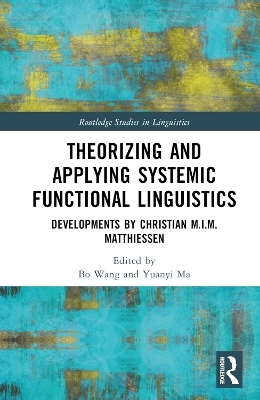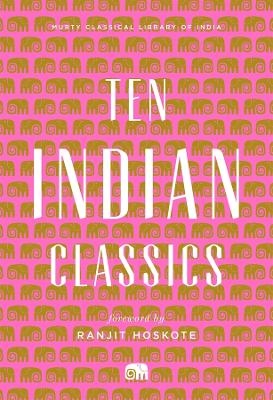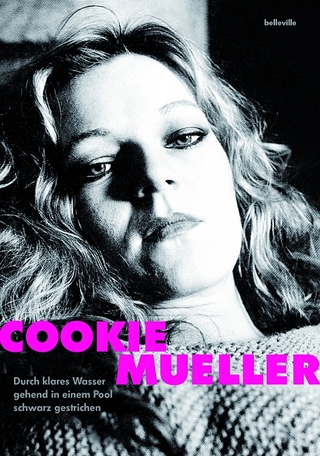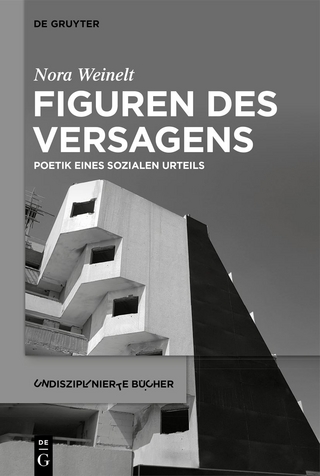
Theorizing and Applying Systemic Functional Linguistics
Routledge (Verlag)
978-0-367-48489-7 (ISBN)
This collection reflects on developments in the field of Systemic Functional Linguistics (SFL) as embodied in the work of Christian M.I.M. Matthiessen, highlighting his diverse contributions to the field from theoretical and applied perspectives.
The book surveys Matthiessen’s academic career and illustrates the myriad ways in which his work has reverberated through to current innovations in SFL research. The book also exhibits his theoretical contributions to major linguistic topics and his influence on the development of SFL. Written by some of the world’s foremost scholars in the field, chapters cover such topics as theories of SFL and its applications in different domains as well as the developmental trajectories of SFL in major geographic areas.
Addressing the key issues in SFL through the lens of Matthiessen’s career, this book is an accessible resource for students and scholars in systemic functional linguistics, as well as those interested in the systemic functional approach in related areas within linguistics.
Bo Wang is Research Assistant Professor at the Faculty of Arts and Humanities, University of Macau. Yuanyi Ma is the co-author of several books on Systemic Functional Linguistics, such as Translating Tagore’s Stray Birds into Chinese, Systemic Functional Translation Studies, Systemic Functional Insights on Language and Linguistics, and Introducing M.A.K. Halliday.
List of Figures
List of Tables
List of Contributors
Acknowledgements
Abbreviations
Introduction
BO WANG AND YUANYI MA
PART I
Christian Matthiessen and systemic functional theory
1 Navigating in semiological space: Theory and Matthiessonian cartography, from typology to register and artificial intelligence
DAVID G. BUTT AND ANNABELLE LUKIN
Preface
1.1 Introduction
1.2 An international troubadour of linguistics
1.3 A “magnum opus”
1.4 Matthiessen and the challenge of linguistic categories
1.5 Grammars, and the centrality of the maps to sciences of society and mind
1.6 Typological and multilingual work
1.7 Realizational systems: Probabilistic, adaptive systems
1.8 Teaching theory
1.9 Managing complexity amid semiotic evolution: Semogenesis
1.10 Conclusion: Linguistics for grown-ups
Notes
References
2 Christian Matthiessen and register
ERICH STEINER
2.1 Introduction
2.2 Register – situating the concept
2.2.1 Register – origins in Firthian linguistics and Systemic Functional Linguistics
2.2.2 Register – its place in SFL architecture
2.2.3 Register – its place in other linguistic traditions
2.3 Matthiessen and register
2.3.1 Conceptual overviews
2.3.2 Context related to other semiotic systems and individuation/affiliation
2.3.3 A comprehensive research programme: Field-based maps of registers of one language (English)
2.4 Empirical claims and future development
Notes
References
3 Syllable and syllable onsets: Japanese and English: Some insights inspired by Halliday and Matthiessen’s systemic functional linguistic architecture
GERARD O’GRADY
3.1 Introduction
3.2 What would a systemic phonology look like?
3.3 Japanese syllables and English onsets compared and contrasted
3.4 Conclusion
Appendix
Notes
References
PART II
Christian Matthiessen and applications of systemic functional theory
4 Systemic Functional Linguistics: Language description, comparison and typology – Key characteristics
CHRISTIAN M.I.M. MATTHIESSEN
4.1 Introduction: SFL and language description, comparison and typology
4.2 Key characteristics of systemic functional language description, comparison and typology
4.2.1 Key characteristics covered in some detail here
4.2.2 Key characteristics only mentioned here
4.3 Theory of language and descriptions of languages
4.3.1 Theory and description: Hjelmslev, Firth, Halliday
4.3.2 Theory of modern language, description, comparison and descriptive generalizations
4.3.3 The theoretical architecture of language: Dimensionality and basis for comparison
4.4 The primacy of systemic organization
4.4.1 An illustration of the primacy of systemic organization: Modern Standard Arabic
4.4.2 Axis: Paradigmatic (systemic) and syntagmatic (structural)
4.4.3 The systemic composition of languages as systems of system
4.4.4 Reinterpretation of implicational “universals”
4.4.5 Frequency in representative typological samples
4.4.6 Multilingual systems networks
4.5 The cline of instantiation and the probabilistic nature of the linguistic system
4.5.1 Probabilistic profiles
4.5.2 Babies taking statistics
4.6 The inherent variability of the linguistic system
4.6.1 Three kinds of variation
4.6.2 Registerial variation
4.6.3 Registerial variation in context: Field of activity
4.6.4 Variation around the languages of the world seen “from above” and “from below”; and also “from roundabout”
4.7 The content plane: The metafunctional spectral organization of language
4.7.1 The status of the metafunctions
4.7.2 Metafunctional modes of meaning: Complementarity and variation
4.7.3 Logical and experiential complementarity
4.7.4 Examples of diversity in the experiential construal of the “Umwelt” of speakers
4.7.5 Metafunctional modes of meaning, modes of expression and media of expression
4.7.6 Variation in metafunctional combinations
4.8 Semogenesis: Lexicogrammaticalization
4.8.1 “Grammaticalization” in the descriptivetypological literature
4.8.2 Towards a systemic functional account of lexicogrammaticalization
4.8.3 Hierarchy of axis – paradigmatic: decrease in delicacy; rank: descent in rank
4.8.4 Cline of instantiation: Increase in frequency
4.8.5 The spectrum of metafunction: Experiential to interpersonal and textual
4.9 A personal angle
4.10 Conclusion
Notes
References
5 On language and linguistics in health: Christian Matthiessen and health communication research
NEDA KARIMI
5.1 Text generation and health reports
5.2 A socio-semiotic framework for conceptualizing patientcentered care
5.2.1 Patient-centered care
5.2.2 Matthiessen’s (2013) socio-semiotic model
5.3 The patient journey and communication load
5.4 Building research capacity and mentorship
5.5 Final remark
Note
References
6 Christian Matthiessen and verbal art
DONNA R. MILLER
6.1 Introduction
6.2 Building on the Halliday–Hasan verbal art cornerstone
6.3 Amplifying and enriching the SFS legacy
6.3.1 Trinocularity 254
6.3.2 Verbal art from the vantage point of the field of activity
6.3.3 The stratal dispersal of literature
6.3.4 The spectrum of metafunction
6.3.5 The cline of instantiation, meaning potential and register vis-à-vis verbal art
6.4 Parting thoughts
Acknowledgements
Notes
References
PART III
Christian Matthiessen and the global influences of Systemic Functional Linguistics
7 The impact of Christian M.I.M Matthiessen on Systemic Functional Linguistics in Australia
ERNEST S. AKEREJOLA
7.1 Introduction
7.2 Matthiessen in the Australian SFL context
7.3 Matthiessen’s crucial role in SFL advancement in Australia
7.4 Matthiessen’s professional commitments
7.4.1 Professor of Linguistics
7.4.2 The provision of tools for modelling SFL description
7.4.3 The foundation of systemic linguistic typological research groups across and beyond Australia
7.4.4 The Matthiessonian approach
7.4.5 The successful building of the SFL community
7.4.6 An all-round linguistic scholar and his mentoring strategies
7.4.7 The Matthiessonian teaching and supervision
7.5 Matthiessen’s humane intellectualism
7.5.1 The Matthiessonian modus operandi
7.5.2 Postlude to Matthiessen’s mentorship
Notes
References
8 Matthiessen in the Latin American SFL community
JESUS DAVID GUERRA LYONS
8.1 Introduction
8.2 Methodology
8.3 Findings
8.3.1 Quantitative indicators
8.3.2 Qualitative indicators
8.4 Concluding remarks
Notes
References
9 Christian Matthiessen and Systemic Functional Linguistics in Europe
JORGE ARUS-HITA
9.1 Introduction
9.2 Early years: Matthiessen in Sweden
9.3 Influence of Matthiessen’s research
9.4 Specific collaborations
9.5 Christian and Michael
9.6 Conclusion
Acknowledgments
References
Index
| Erscheinungsdatum | 03.01.2024 |
|---|---|
| Reihe/Serie | Routledge Studies in Linguistics |
| Zusatzinfo | 22 Tables, black and white; 42 Line drawings, black and white; 3 Halftones, black and white; 45 Illustrations, black and white |
| Verlagsort | London |
| Sprache | englisch |
| Maße | 152 x 229 mm |
| Gewicht | 580 g |
| Themenwelt | Geisteswissenschaften ► Sprach- / Literaturwissenschaft ► Anglistik / Amerikanistik |
| Geisteswissenschaften ► Sprach- / Literaturwissenschaft ► Literaturwissenschaft | |
| Geisteswissenschaften ► Sprach- / Literaturwissenschaft ► Sprachwissenschaft | |
| ISBN-10 | 0-367-48489-7 / 0367484897 |
| ISBN-13 | 978-0-367-48489-7 / 9780367484897 |
| Zustand | Neuware |
| Informationen gemäß Produktsicherheitsverordnung (GPSR) | |
| Haben Sie eine Frage zum Produkt? |
aus dem Bereich


